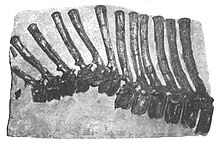Barsboldia
You can help expand this article with text translated from the corresponding article in Dutch. (July 2022) Click [show] for important translation instructions.
|
| Barsboldia | |
|---|---|

| |
| Sacrum of the holotype | |
| Scientific classification | |
| Domain: | Eukaryota |
| Kingdom: | Animalia |
| Phylum: | Chordata |
| Clade: | Dinosauria |
| Clade: | †Ornithischia |
| Clade: | †Ornithopoda |
| Family: | †Hadrosauridae |
| Subfamily: | †Saurolophinae |
| Genus: | †Barsboldia Maryańska & Osmólska, 1981 |
| Type species | |
| †Barsboldia sicinskii Maryańska & Osmólska, 1981
| |
Barsboldia (meaning "of
Discovery
In 1970, a Polish-Mongolian expedition near the Nemegt found the skeleton of an ornithopod and first assigned it to
Description

Barsboldia was a large hadrosaur, previously measured 10 metres (33 ft) in length and 5 metric tons (5.5 short tons) in body mass.
Phylogeny
Maryańska and Osmólska described their new genus as a lambeosaurine (or hollow-crested duckbill), the first from the Nemegt Formation, although it lacked a skull. However, the sacrum has a keel along the bottom, a possible lambeosaurine feature,[5] and the bones closely resemble those of Hypacrosaurus.[4][6] With only one partial skeleton known, and no skull, the genus has been considered dubious[5] or a possible lambeosaurine of uncertain placement.[7] A newer study published in 2011 suggests that Barsboldia is actually a valid saurolophine.[8]
The following cladogram was recovered in the 2011 phylogenetic analysis of Hadrosauroidea by Prieto-Márquez (the relationships within Lambeosaurinae and between basal hadrosauroids aren't shown).[8]


| |||||||||||||||||||||||||||||||||||||||||||||||||||||||||||||||||||||||||||||||||||||||||||||||||||||||||||||||||||||||||
Paleobiology
As a hadrosaurid, Barsboldia would have been a
See also
References
- ^ a b Maryańska, Teresa; Osmólska, Halszka (1981). "First lambeosaurine dinosaur from the Nemegt Formation, Upper Cretaceous, Mongolia". Acta Palaeontologica Polonica. 26: 243–255.
- ^ Paul, Gregory S. (2010). The Princeton Field Guide to Dinosaurs. New Jersey: Princeton University Press. p. 310.
- )
- ^ a b Brett-Surman, Michael K. (1989). A revision of the Hadrosauridae (Reptilia: Ornithischia) and their evolution during the Campanian and Maastrichtian. Ph.D. dissertation. Washington, D.C.: Graduate School of Arts and Sciences of The George Washington University. pp. 1–272.
- ^ ISBN 0-521-55476-4.
- ISBN 0-89950-917-7.
- ^ ISBN 0-520-24209-2.
- ^ S2CID 83677586.
